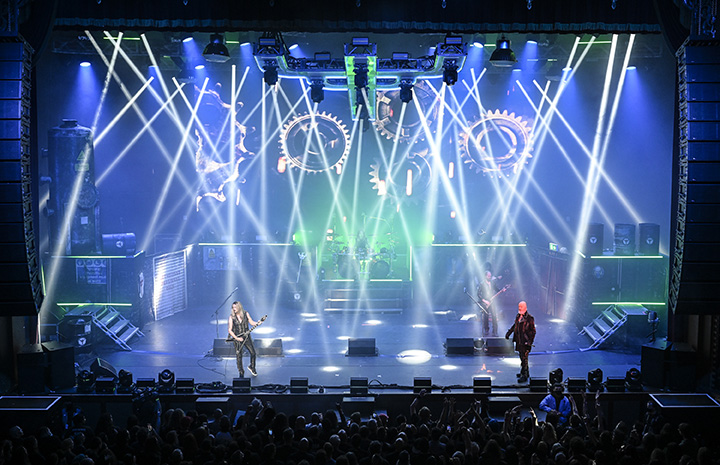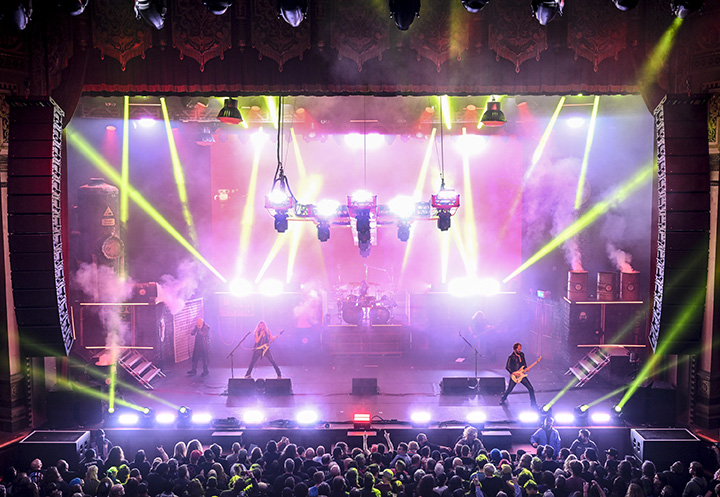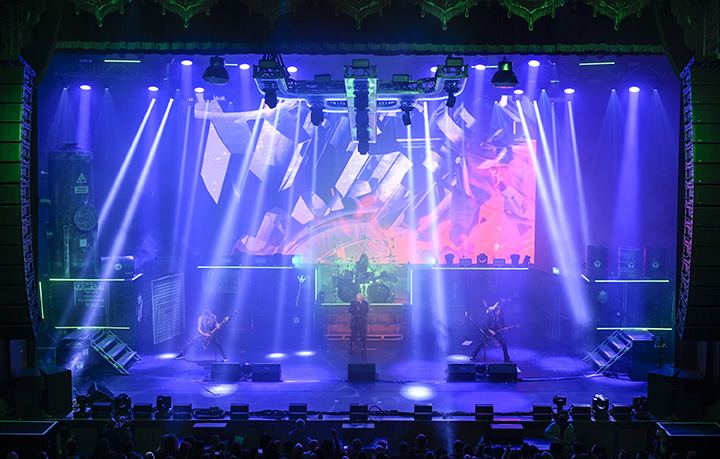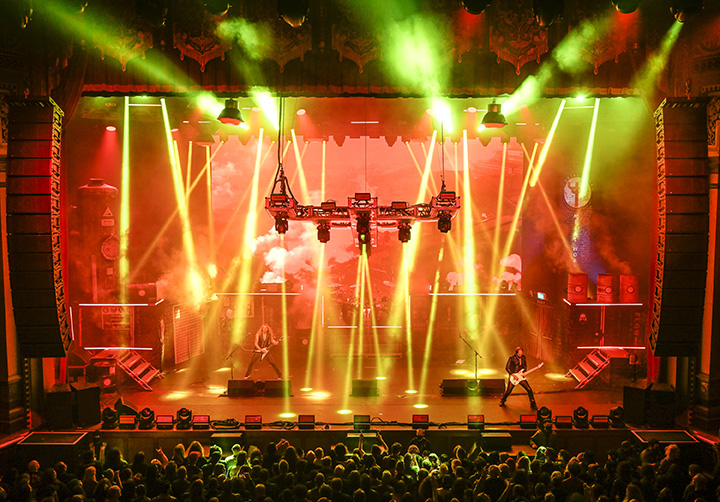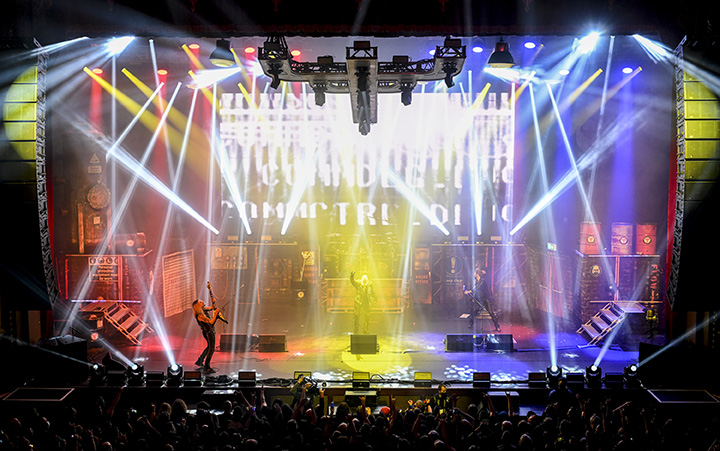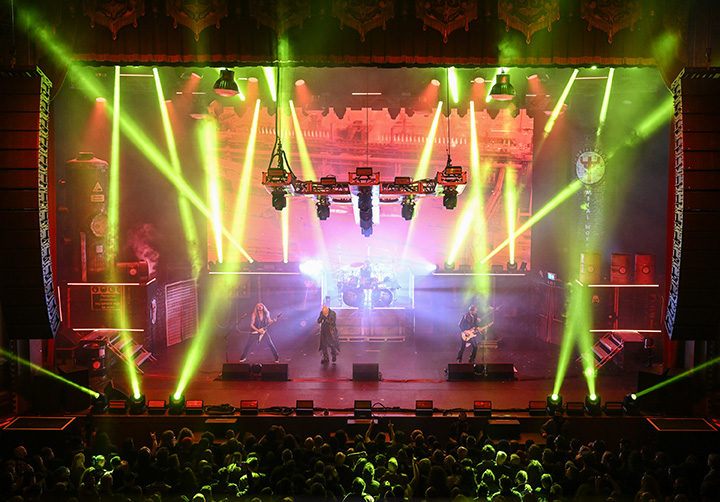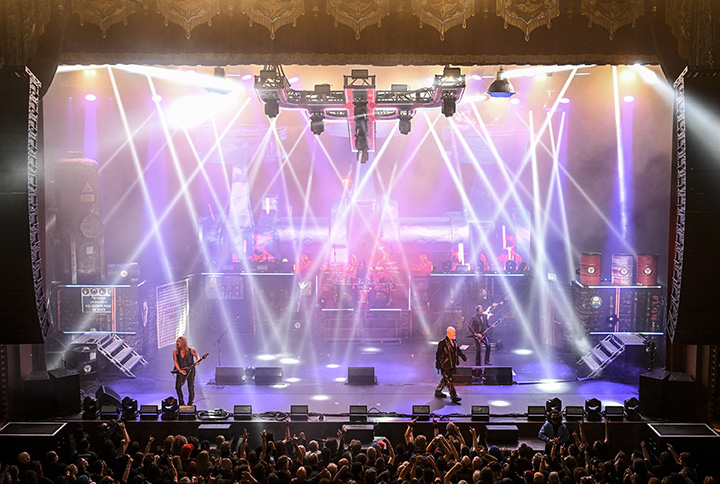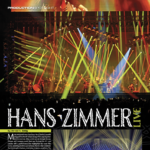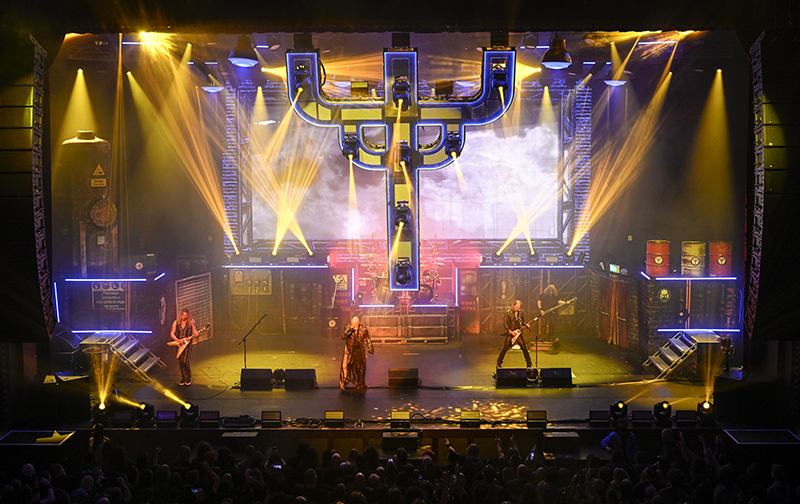
“Living After Midnight” and “You’ve Got Another Thing Coming” are just two Judas Priest hits that have become heavy metal standards on classic rock radio playlists. The British band—with original 1969 co-founder Ian Hill and frontman Rob Halford (since 1973)—has attempted to bring these songs to the stage to celebrate 50 Heavy Metal Years for the third year in a row. Covid-19 canceled the 2020 tour. The 2021 tour lasted only two weeks before 42-year-old lead guitarist Richie Faulkner almost died onstage from a ruptured aorta while doing the final solo during the song, “Painkiller.” Now recovered, the band launched its 2022 tour March 4 and, according to the production team, this third time is a studded leather charm.
PLSN spoke with Production Manager Martin Walker, Lighting Designer Bryan Hartley, and Video Content Creator Mark Devlin about this tour that celebrates half a century of metal music. To set the stage, PRG is providing the lighting, CT Touring the video, and set and drapes come from SGJB Consulting of the UK.
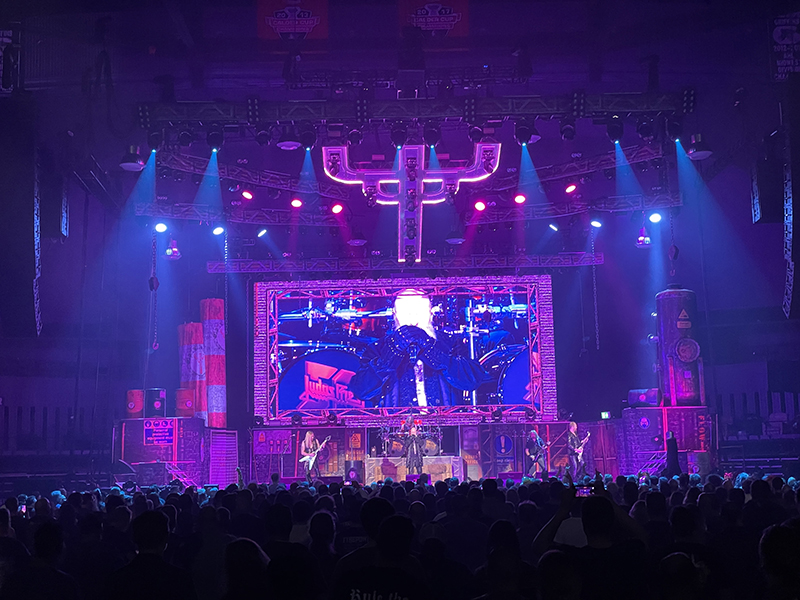
Inflatable Industrial Set
Walker has been with the band almost 24 years. Starting at FOH, he added the production manager role along with set design and looks after the band’s warehouse amongst a few other positions, too. During all those years, he’s only missed one of their TV appearances, while he was on tour with Whitesnake.
This current set design came about from a discussion with Halford. Its industrial look—with tall tanks, barrels, and a grunge factory look—pays homage to their heritage. “They came from the steelworks and factories of the Midlands [which was part of the Industrial Revolution] in England and worked in them until the band was successful enough for them to quit their jobs. The set simply reflects the industrial setting they were all too familiar with once they left school and stepped into working life,” Walker notes. “Sam Booker (of SJGB) brought to life my vision of the stage set; something he’s really good at. We’ve worked together for years and have a great understanding of each other’s ideas.”
The tanks and other factory grunge of the set conveys a sense of “heavy metal” in their own right, but they are not all real. The chimney and the chemical tank are inflatables made by Airworks in the Netherlands. “Sam created the majority of the set, and then I added old oil barrels and pallet steps once we were in rehearsals—the barrels mainly to conceal smoke machines.”
LD Hartley attests to the realness of the fake tanks. “The old oil tank inflatable at stage right looks rusted and corroded, and if you stand a foot away from it, you still think it is real. It is done that well. And then at stage left is an inflatable chimney that comes up at a certain time in a song. We have a smoke machine on top of it to go with the whole factory look.” Out of all the props, the onstage motorcycle is real. Halford has ridden one onto stage since the early 80’s, Walker notes, and it’s wrapped to reflect the current tour’s artwork.
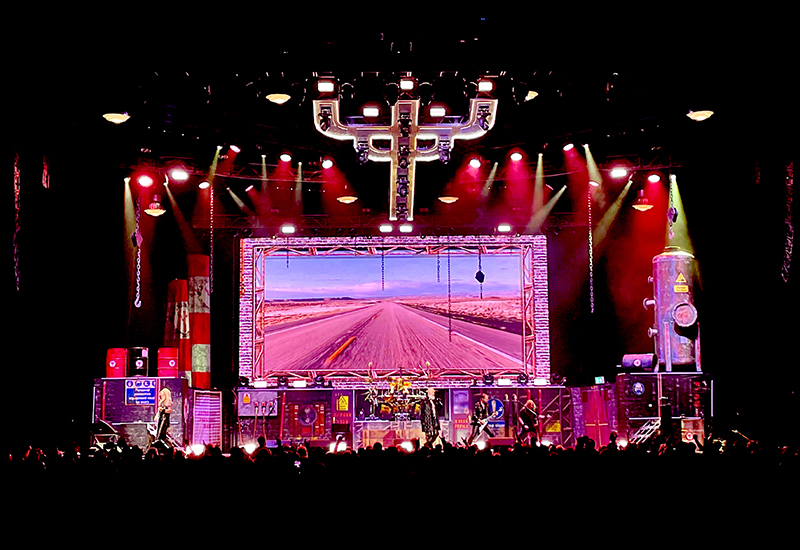
Pitchfork Centerpiece
As a dramatic show opener, all eyes in the audience are on a moving set piece that signals the show to begin. It is dark except for Judas Priest’s emblematic pitchfork, moving toward them from the overhead rig. Fabricated by SGPS of Las Vegas, the pitchfork is created using trussing covered with fascia and outlined with thin LED tape and punctuated with Claypaky Sharpys and GLP JDC1 strobes. “The pitchfork has three Kinesys motors on it, so it comes up and down and tilts toward the audience,” Hartley explains. “It moves at the start, it tilts a few songs into the show, and in the encore, it comes down and I rotate it through red, green, and blue colors. It looks amazing.”
The piece also came out of a discussion with Halford. “Rob came up with a simple pencil drawing of a vision he had,” says Walker. “It began life differently and was going to be a fixed set piece. But after a while we decided a flown moving piece would be more flexible and have more impact. Bryan moved it on from simple trussing to something that we all feel brought it to life even more.”
Says Hartley, “Everyone in the band was skeptical of it at first, but when we first turned it on with the LED and moved it, everyone in the band was, ‘wow, that is intense.’ I’m really proud of it.” Hartley considers the pitchfork as the centerpiece of his design. “Whenever you make a band’s emblem, it’s always tricky; it has to be right,” he explains. “I love the pitchfork. It really does make a statement.” The LD has reached out to SGPS for other set pieces for other artists he’s worked with, including Trans-Siberian Orchestra. “As we’ve gone along on the tour, everyone takes a picture of it at the beginning of the show. That makes me feel good.”
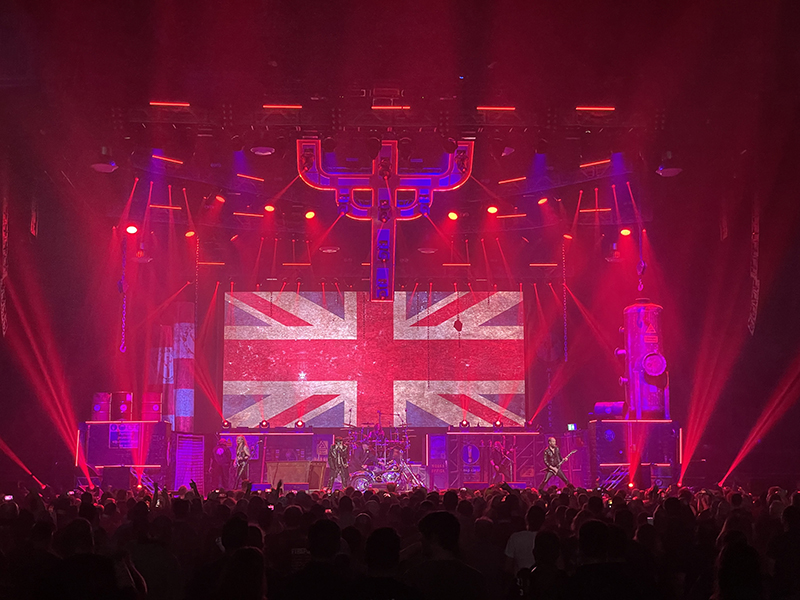
Shining on the Solos
Declaring “nothing wild or out of the ordinary” in his lighting specs, the LD cites a rig of Claypaky Sharpys and a range of Martin by Harman fixtures including MAC Vipers, MAC Quantum washes, a few Rush PARs and VDO Sceptron 10s, and two sizes of TMB ProCan audience blinders. He’s also spec’d a quantity of GLP JDC1 hybrid strobes. “Using the JDC1 strobes with color is perfect for this kind of music,” he says. “The JCD1 also has a middle strip that’s really bright.” He’s also deployed eight industrial lighting fixtures to complement the factory theme.
Four sticks of Tyler Truss—two on each side of the pitchfork—each feature two MAC Viper Profiles interspersed with two MAC Quantum Washes, with four Claypaky Sharpy Profiles together at each end. Along the side of each of the trusses are three TMB ProCan 2-Lite Blinders and two VDO Sceptron 10s. In front of the video wall is a 50’ truss lined with the same fixtures but with four additional GLP JDC1 strobes.
Beyond the pitchfork, some of Hartley’s favorite moments in the show are lighting the guitar solos using the MAC Quantum Washes. “This is a big two-guitar band, and a lot of these songs will have one song with a 30 second solo, then switch to the other guitarist. It’s a cool vibe to do lights on these solos, switching back and forth.”
Under Lighting Crew Chief Tom Bider are the lighting crew consisting of Andrew Mayer, Jen Kerbs, and Graham Hill (who runs the Kinesys automation for the pitchfork and the inflatable chimney onstage).
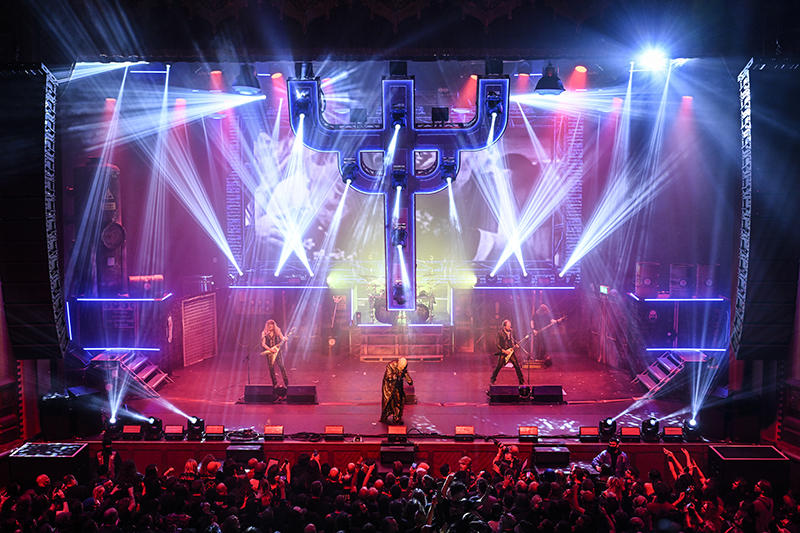
In Control
Hartley carries his own personal MA Lighting grandMA3 light consoles, one active and one spare. “They are great consoles,” he says. “I love them to death.” He’s also deployed a Catalyst V5 media server, owned by the band, to run the video. “From the console I bring up the camera and the Catalyst. The Catalyst also runs the Sceptrons—the LED video battens. I have about 40 Sceptrons and I pump abstract video content through them. The Sceptrons outline the set, and I also have probably 16 or so in the air. It’s a nice look. I use the Sceptrons no matter which band I’m working with,” he notes.
The LED upstage video wall—40’ wide x 20’ high—uses 100 ROE Visual CB5 panels, two Brompton Technology Tessera SX40 LED processors, and two Brompton XD Data Distribution units. CT Touring provides the gear, run by video techs Brandon Otto and Pat Gibbs. “Brandon and Pat are awesome,” Hartley says. “We don’t do a huge amount of I-Mag as the band weren’t big on using it for the whole show. I like using normal video content on the screen to enhance the show.”
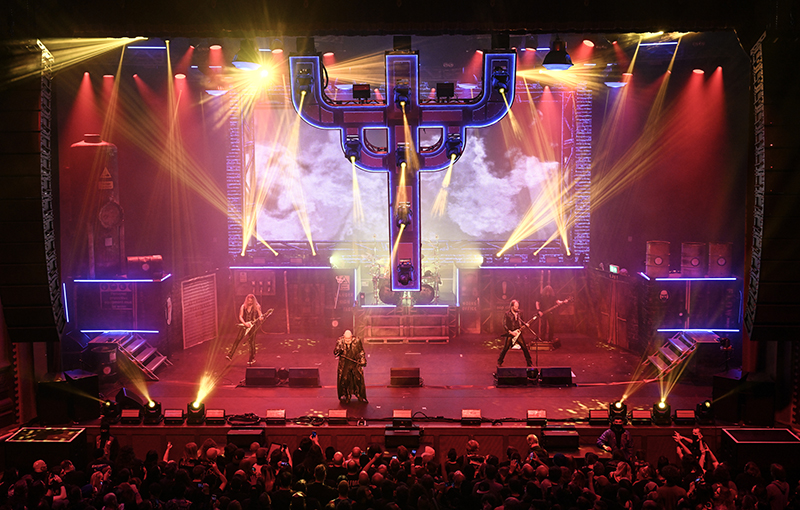
Creating Content via Google Earth
Content Designer Devlin has been creating content for Judas Priest since the 2014-15 Redeemer of Souls tour. “That was the first year the band introduced video into their show,” he notes. “At first the idea of giant video screens on stage had mixed reviews by the band. But it did not take long for them to understand the theatrical possibilities video content gave to the performance of each song.”
Devlin was brought into the mix on this tour after the stage design was worked out. “As Martin revises the final stage design, Rob and I discuss what concepts he has for several of the songs. But he allows me incredible creative freedom to take his ideas and fly. I give the LD clear direction on how I would like the content to be played. But once again, working with talent like Bryan, I don’t want to force my vision on the final product. I make it clear upfront that his creative input on my content is welcome and expected.”
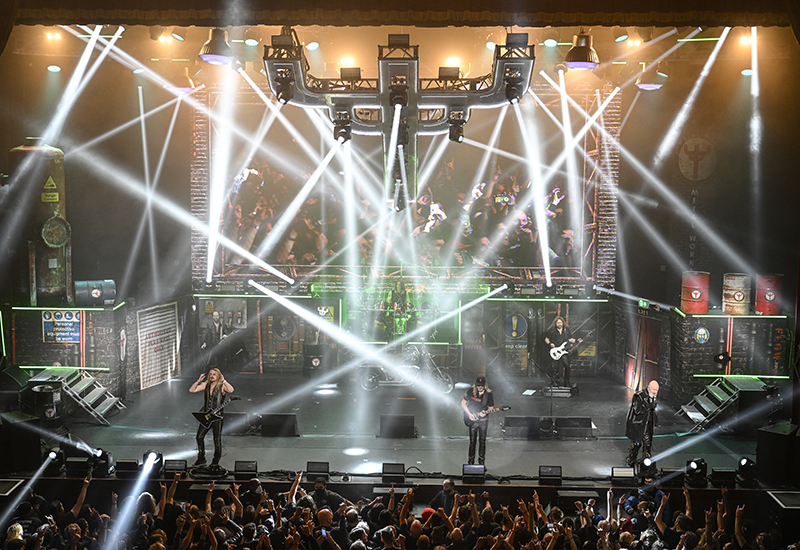
While one would think a half century of performances would amass a treasure trove of video content in the band’s archives, Devlin says they “start from scratch” with everything. He likes to shoot as much original content as possible and delves into his huge video archive that he’s compiled over his 30 years in the business.
While Hartley might call it “normal video content,” the song, “Living After Midnight” required a particularly interesting solution, Devlin explains. “Rob wanted to shoot footage for the band’s hometown in Manchester, England [Editor’s Note: Their hometown is actually Birmingham]. Flights at that time were prohibitively expensive. Instead, I started by researching the town and looked at a ton of still images of the city to find the most scenic camera angles for each location. I hired a local camera operator in Manchester, who happened to be the nephew of bass guitarist Ian Hill. I directed the shoot by using Google Earth to identify exactly where each camera shot was to be set up, and at what camera angle. To add energy to each scene, we shot time lapses for each location over three days. The results were perfect, and the budget was very reasonable.” Devlin has worked with videographers in remote parts of the world where he wasn’t able to get there, but it was his first time to do it using Google Earth. “It was like science fiction!”
Declaring this his “best content ever,” Devlin explains, “Judas Priest creates a very high standard for the video content to attempt to support. That level of performance excited and inspired me. Then Bryan Hartley took the content to an even higher level with the way he combined it with an incredible light show.”
On a night when Devlin found himself part of the audience watching the show, he felt assured of his design when surrounded by a “sea of screens,” he says. “I find that the amount of cell phones videoing the show is an indication of the quality of the show.”
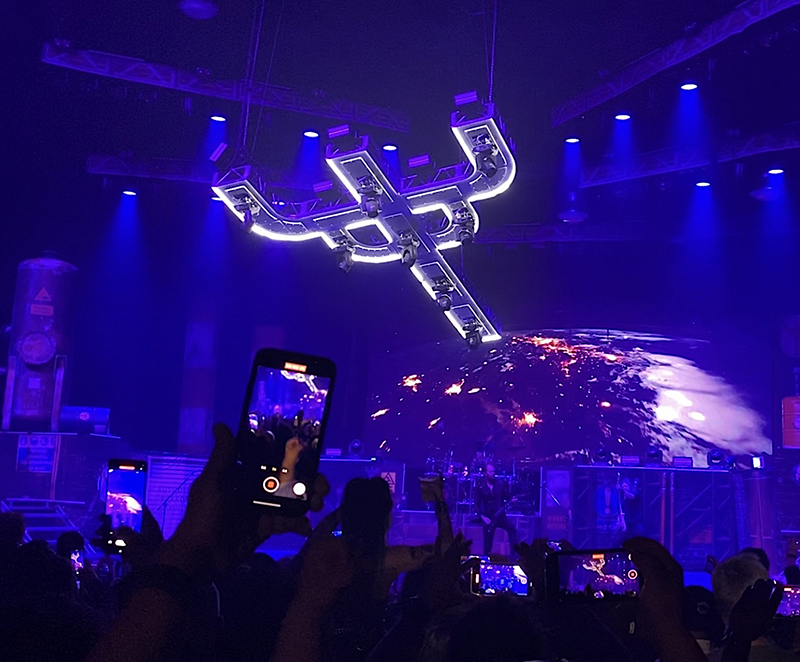
On the Road
The tour travels in six trucks from Ozark Mountain Leasing in the U.S. “I’ve had a reasonably long relationship with Ozark with other bands I’ve worked with in the past,” says Walker, “but this tour (starting in September 2021 and aborting due to a guitarist’s illness) was the first time I took the Judas Priest tour to them. They served us very well and gave us a great team of drivers. I’m hoping it’s the beginning of a long working relationship.”
The crew travels in two 16-berth Beat the Street tour buses. “BTS have changed the game for me over here, as I can fit my crew comfortably into two buses, rather than having to use three—a big money savings,” the PM notes. Hartley adds, “Six trucks, and we have an amazing show that fits in anywhere and looks good everywhere.”
While a crew shortage is a real challenge post-pandemic, Walker says 99% of his team have previously worked for Judas Priest. “We have a very high percentage of people that return—I’m very proud of that and put it down to the organization being a friendly one that respects the crew and enjoys their company. I did struggle a little finding a rigger, but I talked Rick Mooney, the rigger from the previous tour, into returning from his retirement to come out and play again. I’m not sure his wife was as pleased as I was that he said yes!”
Hartley chimes in that he’s happy to be working with vendor PRG, especially with the account rep, Curry Grant, who is as much of an industry legend as the band. “I love Curry Grant,” Hartley says. “Great man, known him for years, and happy he is my guy for Judas Priest.”
Hartley, who started working with Judas Priest a few years ago, says coming into this role as a fan pumps up the passion for this project. “I am such a lucky person,” he says, citing bands he’s worked with over the years including KISS, Aerosmith, and Motley Crüe. “It is very awesome to be out there with Judas Priest and these other acts. Those bands are the ones I grew up listening to, before I thought about doing this [lighting as a career].” Noting how there seem to be fewer veteran heavy metal bands still in existence, Hartley is savoring the moments. “I’m enjoying it so much. Judas Priest is one of my favorite bands,” he says. “They kill it every night. I hope we have many more good years.”
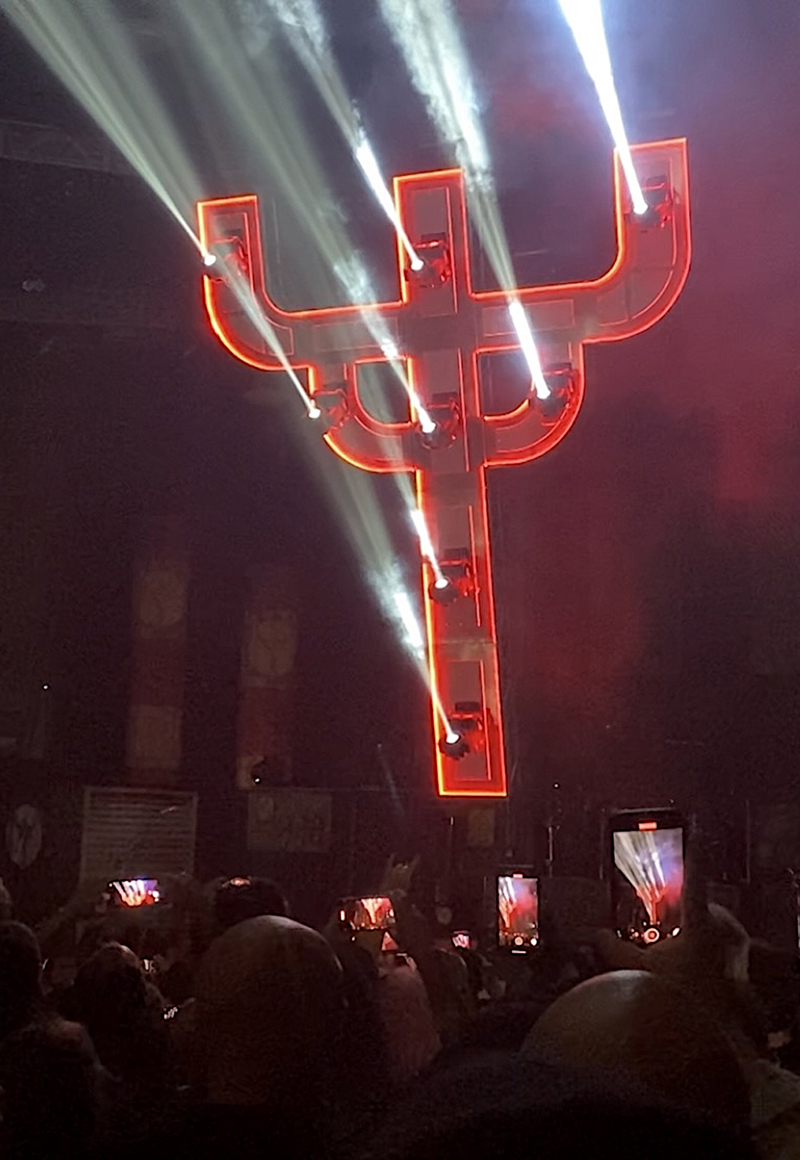

Judas Priest 50 Heavy Metal Years Tour
Production Team
- Lighting Designer: Bryan Hartley
- Video Content Designer: Mark Devlin
- Tour Manager: Wilf Wright
- Production Manager/FOH: Martin Walker
- Production Assistant: Lara Simon
- Stage Manager: Rik Benbow
- Lighting Crew Chief: Tom Bider
- Lighting Crew: Graham Hill, Andrew Mayer, and Jen Kerbs
- Video Techs: Brandon Otto and Pat Gibbs
- Set Carpenter: Julian Aflalo
- Set Carpenter/Pitchfork Tech: Nidge Dobson
- Rigger: Rick Mooney
- Crew Bus Drivers: Geoff McAlister and Henry Jenson
- Lead Truck Driver: Michael Bauer
- Truck Drivers: Brad Turnbough, John Chobot, Walter Hofer, David Love, and Andre Boyd
Vendors (USA)
- Lighting: PRG/Curry Grant
- Video: CT Touring/Brian Thorene
- Video Content: Mark Devlin Visual Design
- Pitchfork Rig Fabrication: SGPS
- Set & Drapes: SJGB Consulting/Sam Booker
- Set Inflatables: Airworks Inflatables
Gear
Lighting
- 2 MA Lighting grandMA3 light Console
- 1 Catalyst V5 Media Server
- 52 Claypaky Sharpy Profile
- 24 Martin MAC Viper Profile
- 18 Martin MAC Quantum Wash
- 6 TMB ProCan 8-Lite Blinder
- 16 TMB ProCan 2-Lite Blinder
- 37 Martin VDO Sceptron 10
- 38 GLP JDC1 Hybrid Strobe
- 4 Martin RUSH PAR 2 RGBW Zoom
- 100 ROE Visual CB5 Panel
Video
- 2 Brompton Technology Tessera SX40 LED Processor
- 2 Brompton Technology XD Data Distribution Unit
- 2 Sony 1500 Camera
- 1 Canon UHD-DIGISUPER 86 Lens
- 1 Canon 24x Lens
- 2 Sony BRC-H900 Camera
Special Effects
- 6 Antari M-7 Fogger with RGBA LEDs
- 4 Martin Jem ZR44 Hi-Mass Fogger
- 2 Reel-EFX DF-50 Diffusion Hazer
- 6 Reel EFX RE 2 Fan
Truss
- 12 Tyler Truss GT Truss, 096V, 8
- 26 Tomcat Truss, TC2020-096B 8’
- 4 Tomcat Truss, TC1212-120B, 10’
- 6 Tomcat Truss, TC1212-096B, 8’
Judas Priest’s 50 Heavy Metal Years is set to tour until June 14, 2023.
More Judas Priest: 50 Years of Heavy Metal tour photos by Steve Jennings:
